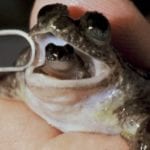 Mysteries
Mysteries  Mysteries
Mysteries  History
History 10 Surprising Stories About the Texas Rangers
 Humans
Humans 10 Philosophers Who Were Driven Mad by Their Own Theories
 Miscellaneous
Miscellaneous 10 Video-Game-Worthy Weapons and Armors from History
 Weird Stuff
Weird Stuff 10 Psychics Who Accurately Predicted Wartime Events
 The Arts
The Arts 10 Pieces of Art Inspired by a Broken Heart
 Health
Health 10 Science Fiction-Sounding New Medical Treatments
 History
History 10 Surprising Facts About the Father of Submarine Warfare
 Space
Space Ten Astonishing New Insights into Alien Worlds
 Weird Stuff
Weird Stuff 10 Bizarre Summer Solstice Rituals Still Practiced Today
 Mysteries
Mysteries Top 10 Haunting Facts About the Ghost Ship MV Alta
 History
History 10 Surprising Stories About the Texas Rangers
 Humans
Humans 10 Philosophers Who Were Driven Mad by Their Own Theories
Who's Behind Listverse?

Jamie Frater
Head Editor
Jamie founded Listverse due to an insatiable desire to share fascinating, obscure, and bizarre facts. He has been a guest speaker on numerous national radio and television stations and is a five time published author.
More About Us Miscellaneous
Miscellaneous 10 Video-Game-Worthy Weapons and Armors from History
 Weird Stuff
Weird Stuff 10 Psychics Who Accurately Predicted Wartime Events
 The Arts
The Arts 10 Pieces of Art Inspired by a Broken Heart
 Health
Health 10 Science Fiction-Sounding New Medical Treatments
 History
History 10 Surprising Facts About the Father of Submarine Warfare
 Space
Space Ten Astonishing New Insights into Alien Worlds
 Weird Stuff
Weird Stuff 10 Bizarre Summer Solstice Rituals Still Practiced Today
10 Recent Stories That Prove Mother Nature Is Screwing With Us
Mother Nature has an awesome reputation. Depending on who you talk to, she’s either wonderful, cruel, awe-inspiring, or horrendously evil. We have a different theory: She’s a practical joker.
A veritable flood of stories have recently featured nature doing stuff that has left our heads spinning. While none of these reports are mysteries, and all of them have rational explanations, they do all seem to have one goal in mind—to leave average laymen scratching their heads and feeling as confused about the world as humanly possible.
10 Wild Smalltooth Sawfish Experience Virgin Births
We all know how sex works. Two people shack up after one too many beers, and nine months and a shotgun wedding later, a little bundle of embarrassment is born. Try telling that to Florida’s smalltooth sawfish. In June 2015, scientists reported that the creatures had started experiencing virgin births.
This sort of reproduction isn’t actually uncommon in the animal kingdom. Invertebrates do it all the time, and it’s also been observed in some captive vertebrates. Sharks, chickens, snakes, and Komodo dragons have all been known to give birth via parthenogenesis, meaning that an unfertilized egg became a living creature. What’s weird about this story is that until now, we’ve assumed that the offspring from these virgin births are both extremely rare and wouldn’t survive in the wild. Florida’s sawfish have proved us utterly wrong.
Over the course of nine years, researchers took DNA samples from 190 smalltooth sawfish in the Florida area. They found that 3 percent (or seven of them) were the offspring of a single parent. While still rare, that’s way more frequent than you’d expect. The offspring also managed to survive in the wild, knocking all of our predictions into a cocked hat.
9 An Insect Has Evolved Working Gears
You may be familiar with the concept of intelligent design. In short, it suggests that organic life is too complex to have evolved and therefore is evidence of a divine creator. It’s a theory that has led to some heated arguments about what constitutes “too complex.” Apparently, Mother Nature has been enjoying these scientific brawls, because in 2013, we discovered something seemingly designed to reignite the debate—an insect with gears.
As hallmarks of the machine age, gears are meant to be unique to humans. Then, they suddenly turned up on juvenile Issus coleoptratus, a tiny hopping insect about 3 millimeters long. Unlike gear shapes that have appeared before on other animals, these gears actually worked. Located on the back legs, the rotating gears allowed the appendages to move simultaneously, causing the insect to hop forward. Even weirder, they featured stuff like rounded corners at the point where each tooth connects to the gear strip, a piece of handiwork that stops the teeth from shearing off. That’s something we’d associate more with bicycles and car gearboxes rather than animals.
No one is suggesting that this is the work of a hands-on creator god. The scientists who found it have a fairly detailed explanation as to how such a mechanism could have evolved naturally. Nonetheless, we’re pretty sure it fits our hypothesis that nature is intentionally messing with our minds.
8 All Mammals Take The Same Time To Urinate
Mammals are a pretty varied group. Picture the smallest Dachshund puppy standing next to the biggest, hoariest old elephant. Then forget that and picture the puppy standing next to a blue whale. That’s how varied our taxonomic class is; we’ve got bladders ranging in size from a few centimeters across to vast tanks capable of holding gallons. Yet, it turns out that nearly all of us have one thing in common: We take the exact same amount of time to pee.
The Georgia Institute of Technology study that observed this was so bizarre that it recently won an Ig Nobel Prize. The team watched 28 videos of mammals peeing on YouTube and then went to the Atlanta Zoo and experienced for themselves the glory of watching multiple animals pass water. In addition to observing whether the animals were able to produce streams, jets, or just droplets of urine, they also took note of the duration. They found all that mammals larger than rats take about 21 seconds to pee.
This means that a cat bladder empties in the same space of time as an elephant bladder. As bizarre as this sounds, there is a logical explanation: The bigger a mammal is, the bigger its urethra is. So while a cat may release a few droplets over 21 seconds, an elephant lets loose an uninterrupted gush over the same duration.
7 There’s No Such Thing As Vegetables

Remember when you were younger, and your mom always told you to eat your vegetables? Well, your past self now has the perfect comeback: You could tell her you can’t eat your vegetables because they don’t exist.
This is something that those who study such things have known for ages, but it was only very recently that a BBC Magazine article brought the extent of the confusion to a wider audience. The first problem is that “vegetable” isn’t a biological term. What we lump together as “vegetables” falls under many different categories. As the article puts it, “Radishes and carrots are roots. Botanically speaking, onions and garlic are bulbs. Potatoes and Jerusalem artichokes are tubers. Asparagus are stems. Lettuces are leaves. Cauliflower and broccoli are inflorescences.”
Vegetables have no widely accepted legal definition, either. In the 19th century, the US Supreme Court ruled that the tomato is a vegetable, but elsewhere in the world, it’s legally defined as a fruit. In 2001, the EU ruled that tomatoes, rhubarb stalks, carrots, and sweet potatoes are all legally defined as fruits if they’re used to make jams or preserves.
Another problem is that in the only other sphere where we use the term “vegetables,” which is cooking, we classify some stuff as vegetables that patently aren’t, such as mushrooms and beans. In short, it’s easier to say that vegetables don’t exist at all.
6 You Might Secretly Be Two People

Barring occasional philosophical musings, most of us think we know who we are. We have a face, an identity, a DNA pattern, and a mind that all add up into making us ourselves. But how would you feel if scientists could actually prove that you were more than one person? Believe it or not, this has literally happened.
In 2014, Lydia Fairchild was struggling to get money from her children’s dad. She took him to court and had them both undergo a paternity test to prove that he was the father. The test came back with an unexpected shock: Although the results showed that he was indeed the father, they also showed that Lydia couldn’t possibly be the mother.
For Lydia, this was an understandable surprise. She’d carried her sons inside her for nine months and went through the ordeal of giving birth, but there was no trace of her DNA in either of them. While the court assumed that she was scamming to get money, the truth turned out to be far stranger: The children were technically mothered by Lydia’s unborn sister.
To explain this, we need to go back to the womb. In early stages of pregnancy, two fetuses can occasionally merge together to form one body, a chimera. As a combination of two different cell lines, these chimeras can then sometimes carry a genome in their eggs or sperm that are different from the rest of their body. In essence, part of their bodies actually belong to someone else.
While it’s rare for a chimera case to reach such extremes, many of us may well be harboring parts of another person inside us. A study at the University of Alberta in Edmonton recently found that 63 percent of women were harboring male cells inside their brain tissue.
5 Chickens Can Be Made To Walk Like Dinosaurs
Mother Nature sure likes her Easter eggs. Perhaps none are quite so obscure or hard to find, though, as this one about barnyard fowl. In early 2014, scientists at the University of Chile observed that it’s possible to recreate how dinosaurs used to walk using a modern chicken. All they had to do was stick a plunger to its butt.
We’re not making this up. These were actual scientists at an actual university who actually wanted to study how T-Rex used to walk. Since every chicken is an extremely distant relative of Jurassic Park’s most famous inmate, they decided that the best way to study it in modern life would be to attach a fake tail to a chicken’s behind.
The experiment was a success. According to their paper (and accompanying video), the team successfully forced the chicken to walk in a more dinosaur-like way. For uncovering this strange little Easter egg that Mother Nature had left lying around, they were awarded an Ig Nobel Prize.
4 Misbehaving Black Holes

On September 24, 2015, the Royal Astronomical Society put out a press release about a supermassive black hole that they’d been studying at the center of a newly observed galaxy. To the team’s surprise, they found that it was too big . . . way too big. Going by current theories, this ginormous black hole was 30 times larger than should have been physically possible.
The idea of a black hole being at the center of a galaxy is nothing new. We’ve known for quite a while that they like to lurk there, presumably to remind the cosmos of the fleeting futility of existence. But they’ve always followed a pretty firm set of cosmic rules, rules that the black hole at the center of nine-billion-year-old galaxy SAGE0536AGN is now flouting. At 350 million times the mass of the Sun, it should be far too big for its parent galaxy. As Dr. Jacco van Loon, astrophysicist at Keele University put it: “This one though is really too big for its boots—it simply shouldn’t be possible for it to be so large.”
Van Loon’s paper also raised the interesting possibility that SAGE0536AGN might not be alone. It could be one of a brand new class of galaxies. We may be forced to rewrite our understanding of galaxy formation.
3 Chimps Have Already Begun The Revolution
2011’s Rise of the Planet of the Apes was a good film for a couple of reasons. One is that it told an arguably dumb story and made it genuinely compelling. The other is that it apparently predicted the future. In April 2015, we got the first warning signs that our captive ape cousins are ready to start the revolution.
At Burgers’ Zoo in the Netherlands, a group of filmmakers were flying a drone over the chimpanzee compound. When they got to the top of the enclosure, something surprising happened. A female chimp used a stick to attack the drone, knocking it from the sky. The group then proceeded to rip the drone to shreds.
That in and of itself isn’t particularly interesting, but what came next is. After studying the footage, scientists released a paper that made a terrifying claim: The chimp who attacked the drone had planned it all in advance.
The drone had already done a practice sweep over the compound, when chimps were seen gathering sticks to attack it with. When it came back, they were waiting for it, allowing it to get close before launching their assault. The video of their faces showed that they weren’t afraid. In other words, the stick hit wasn’t just a lucky strike by an animal flailing around in panic, but rather a deliberately targeted attack.
This is pretty much the first time that we’ve ever seen apes plan and coordinate in such a way before. Add it to other reports about chimps developing tools for consuming alcohol, and we, for one, would like to welcome our new primate overlords.
2 It’s Possible To Give Yourself A ‘Skin Orgasm’

We’ve all experienced it before. That tingling of the skin, that sensation of chills as you listen to a sublimely good piece of music or get to the climax of an awesome movie. It’s a pleasant sensation, no doubt, but few would call it actively orgasmic. In truth, that’s just because we’re the unlucky ones. According to the BBC, some people experience this type of pleasure so intensely that it can be directly comparable to having sex.
The idea seems ridiculous, but apparently it’s just another Easter egg that Mother Nature has thrown out for us to find. Known as a “skin orgasm,” such moments can be triggered by a wide variety of things. For some, it’s a piece of music. For others, a particularly tasty dish, an incredible twist ending to a movie, or even an evocative sound like rustling leaves can do it.
Physiologically, the experience for some people was what you’d expect at the moment of climax. Heart rated increased, faces flushed, goosebumps appeared across the skin, and limbs trembled. It was even suggested that some people become addicted to these feelings, which is why you occasionally meet people who think that there’s nothing wrong with playing “Gangnam Style” five times in a row.
The triggers are different for everyone but usually revolve around taste, touch, sounds, movies, or music. Who knows? You might even have a trigger out there somewhere, just waiting to be discovered.
1 There’s A Village Where Girls Spontaneously Turn Into Boys
Physiological sex is supposed to be an immutable biological law. Even if you’re born transgender, your body won’t catch up with your mind without some medical help. The idea that a girl could spontaneously turn into a boy is the stuff of sci-fi novels and cheap erotic fiction. Don’t tell that to the residents of Salinas in the Dominican Republic, though. Their children have been seeming to switch sex for as long as anyone can remember.
Unlike some cultures, where women can choose to live as men when they reach puberty but still retain their female bodies, the guevedoces change physiologically. In fact, guevedoce translates to “penis at 12.” This is because of a normally incredibly rare genetic mutation that affects 1 in 90 of the village’s children. It causes abnormally low levels of an enzyme known as 5-alpha-reductase, which is responsible for a penis growing while a male baby is in the womb. For the guevedoces, it doesn’t kick in until puberty.
That means that they’re born looking like girls. It’s only when they hit puberty that they suddenly grow a penis, testicles, and muscles. For some parents, it comes as a complete surprise.
Although we’ve known about the guevedoces since the 1970s, they’ve only recently become big news after pharmaceutical companies noticed that they all had small prostates. This observation has allowed the development of a drug that can treat male-pattern baldness and prostate problems. In short, this one village is full of sex-changing lifesavers. It seems that Mother Nature loves nothing more than to shake things up a bit.








